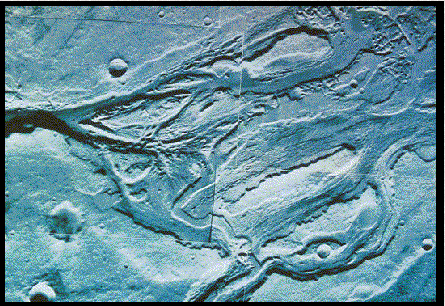 Lesson 7:
Lesson 7:
 Life in the Solar System
Life in the Solar System
|
 7.3
7.3
 Mars' History
Mars' History

|
 |
Figure 7.3.1 Surface features on Mars that appear
Surface features on Mars that appear
to have been formed by liqud water flow.
|
Our chief interest in Mars' history, again, revolves around the crucial
question of whether Mars was always so dry and cold as today, or
whether there once were rivers and seas.
The Mariner 9 Orbiter (launched in 1971) and the two Viking Orbiters
(launched in 1975) took pictures of the surface of Mars, showing dry
valleys and channels presumably eroded by liquid water. Geological
studies of the valley networks suggest that running water gradually
eroded and shaped them. Some valleys show a morphology suggesting the
action of groundwater sapping, when a river is fed by a spring and
the valley grows by headwords erosion. Others seem to have been
produced by precipitation runoff.
The valley networks are nearly completely restricted to ancient upper
highlands, dated 3.5 to 4.0 billion years old (from the quantity of
impact craters). From this it is inferred that environmental
conditions on Mars must have been conducive to liquid water at this
distant time. The surface temperature must have been above zero
degrees Celsius to allow valleys to form, irrespective of whether
this was by sapping or precipitation. In addition to the valley
networks there is other evidence of high erosion rates on early Mars.
Prominent in this is the degradation of ancient craters and similar
surface features on the ancient terrain (about 3.8 billion years old
or older). Terrain features formed later show a much lower rate of
erosion.
The most likely mechanism for the formation of a warmer, wetter Mars in
the past would be a large greenhouse effect. The greenhouse effect
occurs when visible sunlight passes through the atmosphere and is
absorbed directly on the planet's surface. The surface, in turn,
radiates energy in the invisible, infrared; atmospheric greenhouse
gases absorb some of this outward radiation, releasing heat and
warming both the atmosphere and the surface. Today, Mars has only a
very thin CO2 atmosphere (0.006 bar surface pressure,) and
therefore but a modest greenhouse effect.
Computational climate calculations generate a discrepancy. According to computer
simulations of how stars evolve over billions of years, the Sun in
the time of Mars' infancy is estimated to have been 25-30% less
luminous than today. However, from geological and biological evidence
Mars and the Earth are thought to have been warmer than they
currently are, raising a problem known as The Faint Young Sun
Paradox. Ammonia (NH3), a strong greenhouse gas, was once
thought to be the component of the early atmosphere of Mars and the
Earth to account for this, but it is now realized that NH3
could not survive long enough to have an effect before its
destruction by sunlight. So the theory was replaced by atmospheres of
carbon dioxide (CO2) and water vapor (H2O).
These gases are likely to have been vented from the hot convecting
mantle of the planet and also contributed by periodic cometary or
asteroid impacts.
Currently, climate simulations of early Mars have tried to explain the
unequivocal evidence of running water 3.5-4.0 billion years ago with
a thicker CO2 atmosphere. But we do not know whether the
"warm, wet" period persisted for 0.5 billion years or was
merely episodic for a much shorter period like millennia. Alternative
possibilities are that the early Sun was brighter than current
astrophysical theory suggests, or that valleys somehow formed in
colder conditions. Resolving these issues will require further
exploration of Mars.
|





















